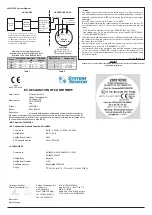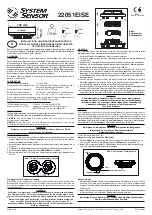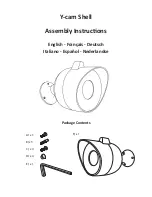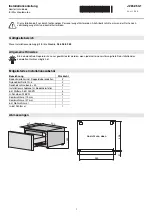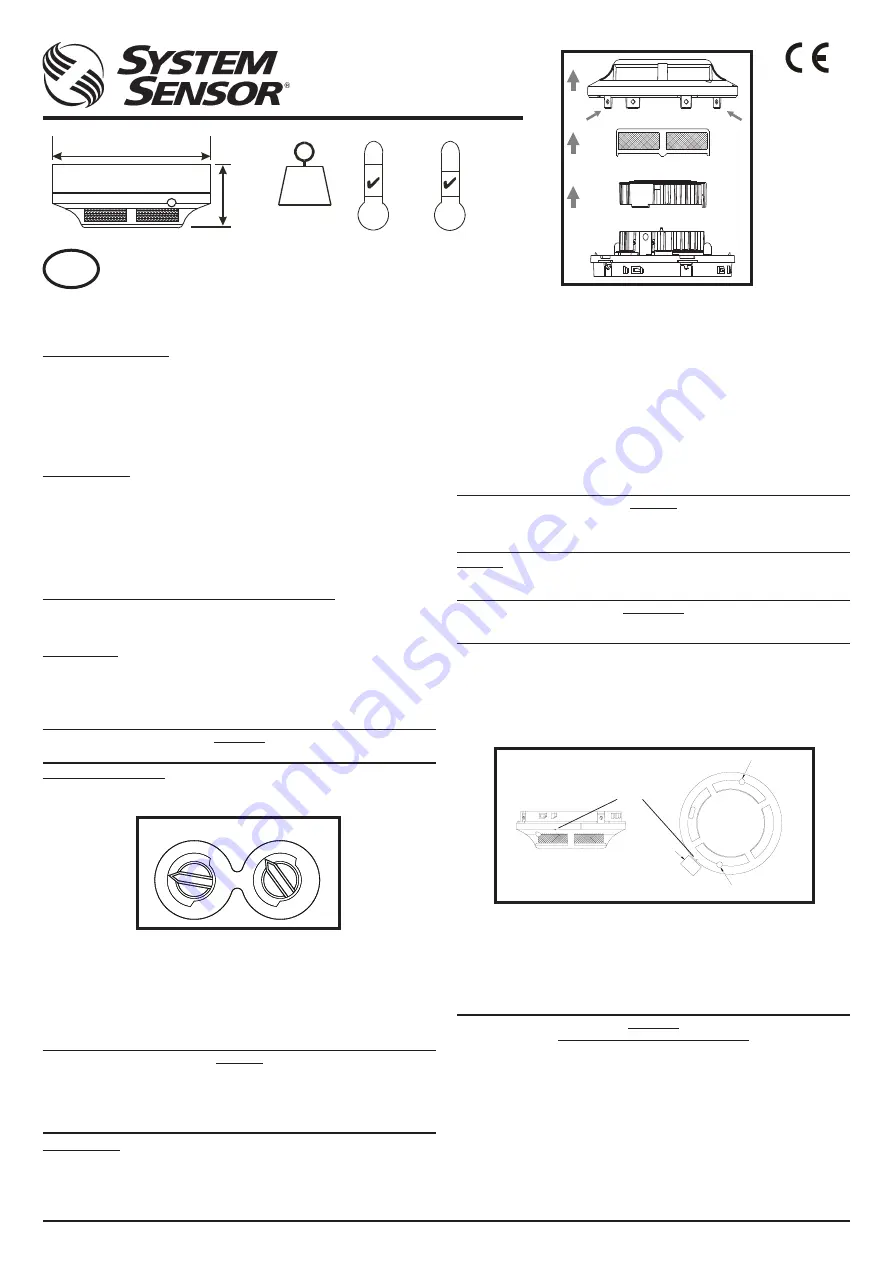
Pittway Tecnologica Srl, Via Caboto 19/3, 34147 Trieste, ITALY
I56-3310-003
D200-51-00
22051EISE
0832
0832-CPD-0199
102 mm
47 mm
B501AP
-20°C
60°C
T4
-20°C
40°C
T5
112.5g
INSTALLATION AND MAINTENANCE INSTRUCTIONS
FOR MODEL 22051EISE INTRINSICALLY SAFE
INTELLIGENT PHOTO ELECTRONIC SMOKE SENSOR
EN
Figure 1: Cleaning
the Sensor
Before installing the sensor, please thoroughly read System Sensor Europe’s “Guide
to Intelligent Fire Systems”. Copies of this manual are available at no charge from
System Sensor.
GENERAL DESCRIPTION
Model 22051EISE is an intrinsically safe smoke detector that combines a photo
electronic sensing chamber with analogue addressable communications and is for use
in hazardous areas where potentially explosive atmospheres are likely to arise. The
classification of equipment required must be confirmed with your responsible authority.
The sensor communicates via a dedicated Galvanic Isolator Barrier with an IST200
Translator Module which relays the data to the Control Panel. Rotary decade switches
are provided for setting the sensor address.
Two LEDs on each sensor provide a local 360° visible sensor indication.
SPECIFICATIONS
Operating Voltage Range:
15 to 24 VDC
Max. Avg. Standby Current:
220 µA @20 VDC (One communication every 5
sec. With LED blink enabled)
Max. Alarm Current (LED on):
3 mA @ 24 VDC
Operating Humidity Range:
10% to 93% Relative Humidity, Non-Condensing
Intrinsic Safety Rating:
Ex ia IIC T5, T4
This detector has been independently tested and certified to EN54 part 7: 2000 and
BASEEFA approved for intrinsic safety.
ACCESSORIES (Available Separately from System Sensor)
IST200 Translator Module
May drive up to 15 22051EISE sensors
Pepperl and Fuchs Y72221
Dedicated Galvanic Isolator Barriers for
22051EISE (drive up to 15 sensors).
WIRING GUIDE
Refer to the installation instructions supplied with the IST200 Translator Module, and
B501AP Base for wiring details.
Note 1:
All wiring must conform to applicable local and national codes and regulations.
Note 2:
Verify that all sensor bases are installed and that polarity of the wiring is
correct at each base.
WARNING
Disconnect loop power before installing sensors. Notify proper authorities.
SENSOR INSTALLATION
1. Set the sensor address (see figure 2) by turning the two rotary switches, selecting a
number between 01and 99. Record the address on the label attached to the base.
4
4
0
2
3
1
0
ONES
TENS
2
3
1
6 7
5
5
9
8
6
9
8
7
2. Insert the sensor into the base and rotate it clockwise until it locks into place.
3. After all the sensors have been installed, apply power to the system.
4. Test the sensor as described under
TESTING.
5. Reset the sensor by communication command from the panel.
Tamper-Resistance.
Model 22051EISE includes a feature that, when activated, prevents removal of the
sensor without the use of a tool. Refer to the installation instructions for the sensor
base for details of how to use this feature.
CAUTION
Dust covers help to protect units during shipping and when first installed.
They are not intended to provide complete protection against contamination
therefore sensors should be removed before construction, major re-decoration
or other dust producing work is started. Dust covers must be removed before
system can be made operational.
MAINTENANCE
Before cleaning, disable the system to prevent unwanted alarms:
1. Remove the sensor to be cleaned from the system.
2. Gently release each of the four cover removal tabs that hold the cover in place (see
figure 1) and remove the cover.
3. Vacuum the outside of the screen carefully without removing it.
4. Remove the sensor screen. Pull the screen straight away from the sensing chamber
until it snaps out of place.
5. Remove the chamber cover by pulling it gently away from the sensing chamber until
it snaps out of place.
6. Use a vacuum cleaner and/or clean, compressed air to remove dust and debris
from the sensing chamber and sensing chamber cover.
7. Re-install the sensing chamber cover by aligning the arrow moulded on the cover
with the arrow printed on the circuit board and sliding the cover over the chamber,
gently pressing it home until it snaps into place.
8. Re-install the sensing chamber screen by sliding it over the sensing chamber.
Rotate the screen until the locating tabs on the bottom rim locate in the cutouts in
the chamber base, and the top of the screen is flush with the top of the chamber.
9. Re-install the sensor cover. Use the cover removal tabs and LEDs to align the cover
with the sensor. Snap the cover into place.
10. When all sensors have been cleaned, restore power to the loop and test the sensor(s)
as described under
TESTING
.
CAUTION
The Detector has a plastic enclosure that may present an electrostatic risk and
must not be installed in a position where it may be subject to a high dust-laden
air flow. Clean only with a damp cloth and do not rub.
TESTING
Sensors must be tested after installation and following periodic maintenance. Disable
the zone or system undergoing maintenance to prevent unwanted alarms.
IMPORTANT
If testing is carried out using non-intrinsically safe methods, it must be
conducted outside the hazardous area.
Test the sensors as follows:
Magnet Test Method
1. Test the sensor by positioning the test magnet (model M02-04-00 optional) against
the sensor body approximately 2cm from LED 1, indicated by a mark on the detector
cover as shown in figure 3.
2. Both LED’s on the detector should latch into alarm within 30 seconds, activating the
control panel.
Smoke Method
1. Using generated smoke, or synthetic smoke aerosol from an approved manufacturer
such as No Climb Products Ltd, subject the detector to controlled amounts of smoke
in accordance with local codes of practice and manufacturer recommendations.
2. Both LED’s on the detector should latch into alarm within 30 seconds, activating the
control panel.
After completion of the test notify the proper authorities that the system is operational.
WARNING
LIMITATIONS OF SMOKE DETECTORS
Smoke detectors must be used in conjunction with compatible equipment.
Smoke detectors will not sense fires which start where smoke does not reach the
detectors.
A detector may not detect a fire developing on another level of a building.
Smoke detectors also have sensing limitations. Consideration must be made of the
environment when selecting fire detectors.
Smoke detectors cannot last forever.
Smoke detectors contain electronic parts. Even
though detectors are made to last over 10 years, any of these parts could fail at any
time. Therefore, test your smoke detector system at least semiannually. Clean and take
care of your smoke detectors regularly. Taking care of the fire detection system you
have installed will significantly reduce your product liability risks.
Figure 3: Test Magnet Position
Mark on Cover
LED 2
LED 1
Test Magnet
Figure 2: Rotary Decade Address Switch
TENS
UNITS


